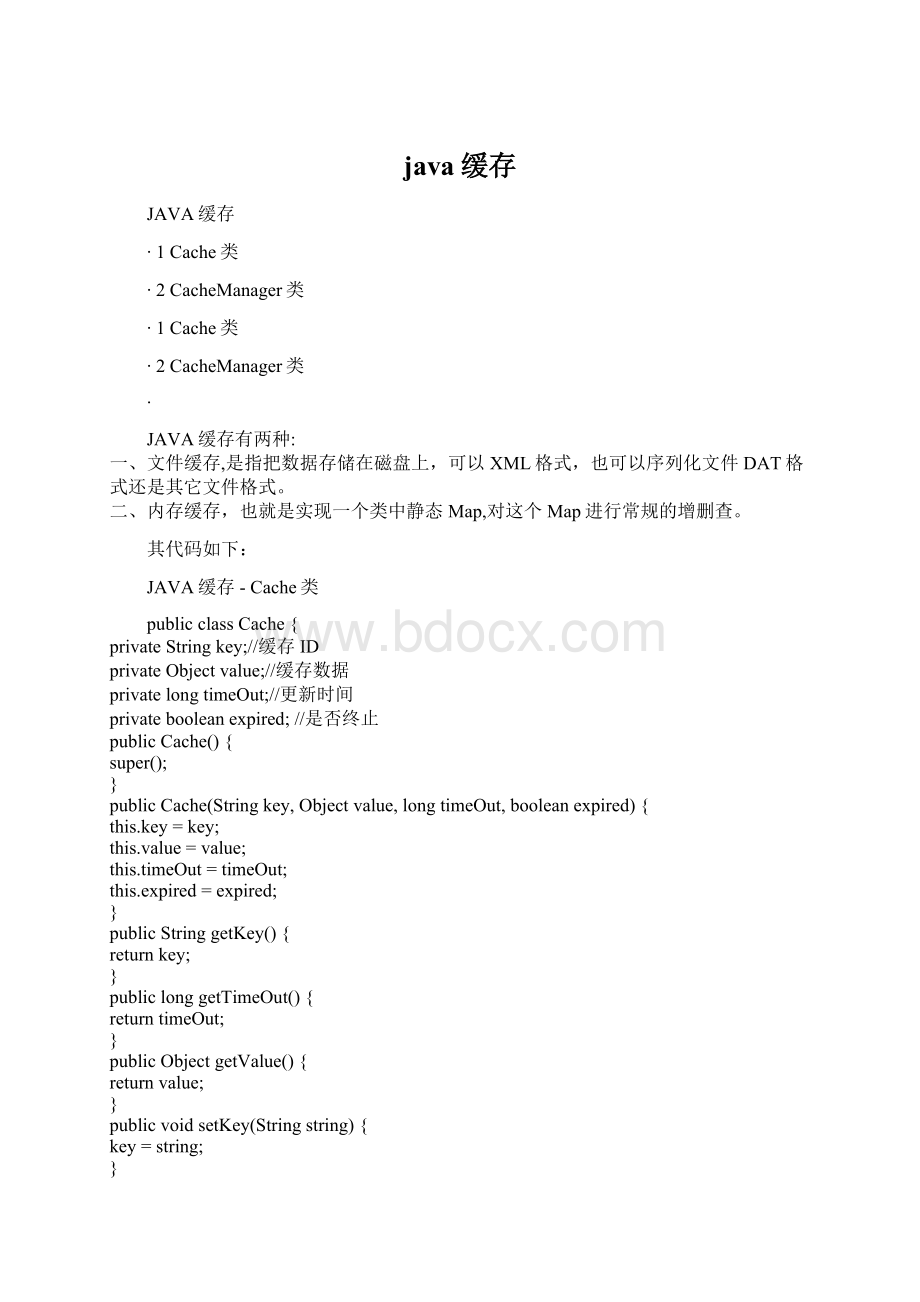java缓存.docx
《java缓存.docx》由会员分享,可在线阅读,更多相关《java缓存.docx(25页珍藏版)》请在冰豆网上搜索。

java缓存
JAVA缓存
∙1Cache类
∙2CacheManager类
∙1Cache类
∙2CacheManager类
∙
JAVA缓存有两种:
一、文件缓存,是指把数据存储在磁盘上,可以XML格式,也可以序列化文件DAT格式还是其它文件格式。
二、内存缓存,也就是实现一个类中静态Map,对这个Map进行常规的增删查。
其代码如下:
JAVA缓存-Cache类
publicclassCache{
privateStringkey;//缓存ID
privateObjectvalue;//缓存数据
privatelongtimeOut;//更新时间
privatebooleanexpired;//是否终止
publicCache(){
super();
}
publicCache(Stringkey,Objectvalue,longtimeOut,booleanexpired){
this.key=key;
this.value=value;
this.timeOut=timeOut;
this.expired=expired;
}
publicStringgetKey(){
returnkey;
}
publiclonggetTimeOut(){
returntimeOut;
}
publicObjectgetValue(){
returnvalue;
}
publicvoidsetKey(Stringstring){
key=string;
}
publicvoidsetTimeOut(longl){
timeOut=l;
}
publicvoidsetValue(Objectobject){
value=object;
}
publicbooleanisExpired(){
returnexpired;
}
publicvoidsetExpired(booleanb){
expired=b;
}
}
//测试类,
classTest{
publicstaticvoidmain(String[]args){
System.out.println(CacheManager.getSimpleFlag("alksd"));
//CacheManager.putCache("abc",newCache());
//CacheManager.putCache("def",newCache());
//CacheManager.putCache("ccc",newCache());
//CacheManager.clearOnly("");
//Cachec=newCache();
//for(inti=0;i<10;i++){
//CacheManager.putCache(""+i,c);
//}
//CacheManager.putCache("aaaaaaaa",c);
//CacheManager.putCache("abchcy;alskd",c);
//CacheManager.putCache("cccccccc",c);
//CacheManager.putCache("abcoqiwhcy",c);
//System.out.println("删除前的大小:
"+CacheManager.getCacheSize());
//CacheManager.getCacheAllkey();
//CacheManager.clearAll("aaaa");
//System.out.println("删除后的大小:
"+CacheManager.getCacheSize());
//CacheManager.getCacheAllkey();
}
}
JAVA缓存-CacheManager类
publicclassCacheManager{
privatestaticHashMapcacheMap=newHashMap();
//单实例构造方法
privateCacheManager(){
super();
}
//获取布尔值的缓存
publicstaticbooleangetSimpleFlag(Stringkey){
try{
return(Boolean)cacheMap.get(key);
}catch(NullPointerExceptione){
returnfalse;
}
}
publicstaticlonggetServerStartdt(Stringkey){
try{
return(Long)cacheMap.get(key);
}catch(Exceptionex){
return0;
}
}
//设置布尔值的缓存
publicsynchronizedstaticbooleansetSimpleFlag(Stringkey,booleanflag){
if(flag&&getSimpleFlag(key)){//假如为真不允许被覆盖
returnfalse;
}else{
cacheMap.put(key,flag);
returntrue;
}
}
publicsynchronizedstaticbooleansetSimpleFlag(Stringkey,longserverbegrundt){
if(cacheMap.get(key)==null){
cacheMap.put(key,serverbegrundt);
returntrue;
}else{
returnfalse;
}
}
//得到缓存。
同步静态方法
privatesynchronizedstaticCachegetCache(Stringkey){
return(Cache)cacheMap.get(key);
}
//判断是否存在一个缓存
privatesynchronizedstaticbooleanhasCache(Stringkey){
returncacheMap.containsKey(key);
}
//清除所有缓存
publicsynchronizedstaticvoidclearAll(){
cacheMap.clear();
}
//清除某一类特定缓存,通过遍历HASHMAP下的所有对象,来判断它的KEY与传入的TYPE是否匹配
publicsynchronizedstaticvoidclearAll(Stringtype){
Iteratori=cacheMap.entrySet().iterator();
Stringkey;
ArrayListarr=newArrayList();
try{
while(i.hasNext()){
java.util.Map.Entryentry=(java.util.Map.Entry)i.next();
key=(String)entry.getKey();
if(key.startsWith(type)){//如果匹配则删除掉
arr.add(key);
}
}
for(intk=0;kclearOnly(arr.get(k));
}
}catch(Exceptionex){
ex.printStackTrace();
}
}
//清除指定的缓存
publicsynchronizedstaticvoidclearOnly(Stringkey){
cacheMap.remove(key);
}
//载入缓存
publicsynchronizedstaticvoidputCache(Stringkey,Cacheobj){
cacheMap.put(key,obj);
}
//获取缓存信息
publicstaticCachegetCacheInfo(Stringkey){
if(hasCache(key)){
Cachecache=getCache(key);
if(cacheExpired(cache)){//调用判断是否终止方法
cache.setExpired(true);
}
returncache;
}else
returnnull;
}
//载入缓存信息
publicstaticvoidputCacheInfo(Stringkey,Cacheobj,longdt,booleanexpired){
Cachecache=newCache();
cache.setKey(key);
cache.setTimeOut(dt+System.currentTimeMillis());//设置多久后更新缓存
cache.setValue(obj);
cache.setExpired(expired);//缓存默认载入时,终止状态为FALSE
cacheMap.put(key,cache);
}
//重写载入缓存信息方法
publicstaticvoidputCacheInfo(Stringkey,Cacheobj,longdt){
Cachecache=newCache();
cache.setKey(key);
cache.setTimeOut(dt+System.currentTimeMillis());
cache.setValue(obj);
cache.setExpired(false);
cacheMap.put(key,cache);
}
//判断缓存是否终止
publicstaticbooleancacheExpired(Cachecache){
if(null==cache){//传入的缓存不存在
returnfalse;
}
longnowDt=System.currentTimeMillis();//系统当前的毫秒数
longcacheDt=cache.getTimeOut();//缓存内的过期毫秒数
if(cacheDt<=0||cacheDt>nowDt){//过期时间小于等于零时,或者过期时间大于当前时间时,则为FALSE
returnfalse;
}else{//大于过期时间即过期
returntrue;
}
}
//获取缓存中的大小
publicstaticintgetCacheSize(){
returncacheMap.size();
}
//获取指定的类型的大小
publicstaticintgetCacheSize(Stringtype){
intk=0;
Iteratori=cacheMap.entrySet().iterator();
Stringkey;
try{
while(i.hasNext()){
java.util.Map.Entryentry=(java.util.Map.Entry)i.next();
key=(String)entry.getKey();
if(key.indexOf(type)!
=-1){//如果匹配则删除掉
k++;
}
}
}catch(Exceptionex){
ex.printStackTrace();
}
returnk;
}
//获取缓存对象中的所有键值名称
publicstaticArrayListgetCacheAllkey(){
ArrayLista=newArrayList();
try{
Iteratori=cacheMap.entrySet().iterator();
while(i.hasNext()){
java.util.Map.Entryentry=(java.util.Map.Entry)i.next();
a.add((String)entry.getKey());
}
}catch(Exceptionex){}finally{
returna;
}
}
//获取缓存对象中指定类型的键值名称
publicstaticArrayListgetCacheListkey(Stringtype){
ArrayLista=newArrayList();
Stringkey;
try{
Iteratori=cacheMap.entrySet().iterator();
while(i.hasNext()){
java.util.Map.Entryentry=(java.util.Map.Entry)i.next();
key=(String)entry.getKey();
if(key.indexOf(type)!
=-1){
a.add(key);
}
}
}catch(Exceptionex){}finally{
returna;
}
}
}
2007-09-29
简单LRU算法实现缓存
最简单的LRU算法实现,就是利用jdk的LinkedHashMap,覆写其中的removeEldestEntry(Map.Entry)方法即可,如下所示:
java代码
1.import java.util.ArrayList;
2.import java.util.Collection;
3.import java.util.LinkedHashMap;
4.import java.util.concurrent.locks.Lock;
5.import java.util.concurrent.locks.ReentrantLock;
6.import java.util.Map;
7.
8.
9./**
10. * 类说明:
利用LinkedHashMap实现简单的缓存, 必须实现removeEldestEntry方法,具体参见JDK文档
11. *
12. * @author dennis
13. *
14. * @param
15. * @param
16. */
17.public class LRULinkedHashMap extends LinkedHashMap {
18. private final int maxCapacity;
19.
20. private static final float DEFAULT_LOAD_FACTOR = 0.75f;
21.
22. private final Lock lock = new ReentrantLock();
23.
24. public LRULinkedHashMap(int maxCapacity) {
25. super(maxCapacity, DEFAULT_LOAD_FACTOR, true);
26. this.maxCapacity = maxCapacity;
27. }
28.
29. @Override
30. protected boolean removeEldestEntry(java.util.Map.Entry eldest) {
31. return size() > maxCapacity;
32. }
33. @Override
34. public boolean containsKey(Object key) {
35. try {
36. lock.lock();
37. return super.containsKey(key);
38. } finally {
39. lock.unlock();
40. }
41. }
42.
43.
44. @Override
45. public V get(Object key) {
46. try {
47. lock.lock();
48. return super.get(key);
49. } finally {
50. lock.unlock();
51. }
52. }
53.
54. @Override
55. public V put(K key, V value) {
56. try {
57. lock.lock();
58. return super.put(key, value);
59. } finally {
60. lock.unlock();
61. }
62. }
63.
64. public int size() {
65. try {
66. lock.lock();
67. return super.size();
68. } finally {
69. lock.unlock();
70. }
71. }
72.
73. public void clear() {
74. try {
75. lock.lock();
76. super.clear();
77. } finally {
78. lock.unlock();
79. }
80. }
81.
82. public Collection> getAll() {
83. try {
84. lock.lock();
85. return new ArrayList>(super.entrySet());
86. } finally {
87. lock.unlock();
88. }
89. }
90.}
91.
如果你去看LinkedHashMap的源码可知,LRU算法是通过双向链表来实现,当某个位置被命中,通过调整链表的指向将该位置调整到头位置,新加入的内容直接放在链表头,如此一来,最近被命中的内容就向链表头移动,需要替换时,链表最后的位置就是最近最少使用的位置。
LRU算法还可以通过计数来实现,缓存存储的位置附带一个计数器,当命中时将计数器加1,替换时就查找计数最小的位置并替换,结合访问时间戳来实现。
这种算法比较适合缓存数据量较小的场景,显然,遍历查找计数最小位置的时间复杂度为O(n)。
我实现了一个,结合了访问时间戳,当最小计数大于MINI_ACESS时,就移除最久没有被访问的项:
java代码
1.import java.io.Serializable;
2.import java.util.ArrayList;
3.import java.util.Collection;
4.import java.util.HashMap;
5.import java.util.Iterator;
6.import java.util.Map;
7.import java.util.Set;
8.import java.util.concurrent.atomic.AtomicInteger;
9.import java.util.concurrent.atomic.AtomicLong;
10.import java.util.concurrent.locks.Lock;
11.import java.util.concurrent.locks.ReentrantLock;
12.
13./**
14. *
15. * @author dennis
16. * 类说明:
当缓存数目不多时,才用缓存计数的传统LRU算法
17. * @param
18. * @param
19. */
20.public class LRUCache implements Serializable {
21.
22. private static final int DEFAULT_CAPACITY = 100;
23.
24. protected Map